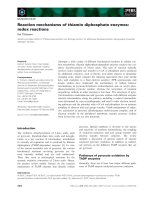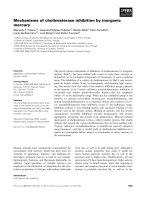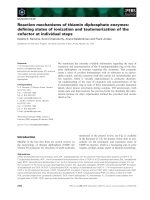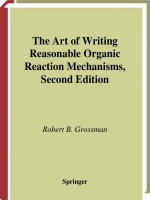Inorganic reaction mechanisms vol 5
Bạn đang xem bản rút gọn của tài liệu. Xem và tải ngay bản đầy đủ của tài liệu tại đây (35.09 MB, 474 trang )
www.pdfgrip.com
www.pdfgrip.com
A Specialist Periodical Report
Inorganic Reaction Mechanisms
Volume 5
A Review of the Literature Published between
January 1975 and June 1976
Senior Rep0 rter
A. McAuley, Department of Chemistry, University of Vidoria,
British Columbia, Canada
Reporters
J. Burgess, University of Leicester
R. D. Cannon, University of East Anglia
J . N . Davidson, Heriot-Watt University, Edinburgh
D. N . Hague, University of Kent
A. G. Lappin, Purdue University, Lafayette, Indiana, U.S.A.
P . Moore, University of Warwick
6. Stedman, University College, Swansea
The Chemical Society
Burlington House, London, WIV OBN
www.pdfgrip.com
I S B N : 0 85186 295 0
I SSN : 0305-8255
Library of Congress Catalog No. 73-642977
Copyright 0 1977
The Chemical Society
All Rights Reserved
No part of this book may be reproduced or transmitted
in any form or by any means - graphic, electronic,
including photocopying, recording, taping or
information storage and retrieval systems - without
written permission from The Chemical Society.
Printed in Great Britain by
Adlard & Son Ltd.
Bartholomew Press, Dorking
www.pdfgrip.com
Foreword
In this volume, the format, coverage, and approach in dealing with various aspects
of Inorganic Reaction Mechanisms are similar to those adopted for the previous
volumes of the series. Once again, rather than make an attempt at cataloguing all the
articles in which mention is made of mechanism, we have chosen (with an eye on
volume size and cost!) to concentrate on papers in which kinetics and mechanisms in
solution form the principal interest. This policy inevitably leads to mention of some
papers being cursory with a consequent loss of subtlety. It is our hope, however, that
any resultant oversimplification or misrepresentation is minimal. Review articles
cited are those which should be accessible to the great majority of readers.
The period of literature coverage extends from January 1975 to June 1976. The
boundaries at both ends are somewhat vague since not all libraries have issues available at the same time. Care has been taken to ensure that an overlap with Volume 4
has been maintained in all areas. Material which is derived from Chemical Abstracts
rather than from the original source is indicated by inclusion of a Chem. Abs.
citation in the reference quoted. References to the Russian literature derived from
this source quote the page number of the original article whereas those giving the
title of the English translation quote the page number of the translation.
As in previous volumes, kinetic data are reported in the form (Ea,or logA or
AH* and AS*)or units (SI or other) used in the original article, although some
conversions have been made both in the text and in the tables where comparisons are
required.
The Reporters are grateful to many of their colleagues for helpful comments. We
are particularly indebted to Drs R. W. D. Kemmitt and A. G. Sykes for their critical
reading of sections of the manuscript.
A. MCAULEY
www.pdfgrip.com
www.pdfgrip.com
Contents
Part I Electron Transfer Processes
Chapter 1 Reactions Between Two Metal Complexes
3
By R. D.Cannon
1 General and Theoretical
Theory of the Electron Transfer Process
Activation Parameters
Stereoselectivity
2 Intramolecular Electron Transfer
The Precursor Complex
Optical Electron Transfer
Symmetrical Exchange Processes
6
8
10
3 Intermolecular Electron Transfer
Methods of Measurement
Complementary Reactions
Chromium(I1)
Vanadium(I1)
Titanium(Ir1)
Uranium(n1)
Neptunium(vI1)
Excited [*Ru(bipy) J2+
Europium(I1)
Other Reagents
Non-complementary Reactions
14
14
14
15
19
19
21
21
21
22
22
23
Chapter 2 Metal Ion-Ligand Redox Reactions
By A. G. Lappin
6
42
1 Chromium(v1)
42
2 Iron(II1)
50
3 Manganese(Ir1)
57
4 Manganese(vr1)
60
www.pdfgrip.com
vi
Contents
5 Cobalt(II1)
64
6 Vanadium(v)
67
7 Thallium(rr1)
70
8 Cerium(1v)
74
9 Copper(I1)
77
10 Miscellaneous Redox Reactions
82
11 Halogens and Halogenate Ions
95
12 Metal-ion Reductions
100
13 Pulse Radiolysis Studies
104
Chapter 3 Reactions of Oxygen and Hydrogen Peroxide
By A. McAuley
107
1 Cobalt(1r) Complexes
107
2 Iron(I1) Complexes
109
3 Copper-(I) and -(II)Complexes
111
4 Other Metal Complexes
113
5 Reactions of Hydrogen Peroxide
114
Part /I Substitution and Related Reactions
Chapter 1 Non-metallic Elements
By G. Stedman
1 Group I11
Boron
Tetrahedral Anions
Boron-Hydrogen Compounds
Boron-Nitrogen and Boron-Phosphorus Compounds
Boron-Oxygen Compounds
Aluminium
Gallium
Indium
Thallium
121
121
121
121
121
122
122
122
123
124
124
www.pdfgrip.com
vii
Contents
2 GroupIV
Carbon
Silicon
Germanium
Tin
Lead
125
125
125
126
126
127
3 GroupV
128
128
130
130
132
132
133
133
134
134
135
Nitrogen
Phosphorus
Oxoanions
Phosphorus-Oxygen-Sulphur Compounds
Phosphorus-Oxygen-Nitrogen Compounds
Phosphazanes
Miscellaneous Compounds
Intramolecular Processes
Arsenic
Antimony
4 GroupVI
Sulphur
Sulphur-Nitrogen Compounds
Intramolecular Processes
Selenium
Tellurium
135
135
138
138
138
139
5 GroupVII
Fluorine
Chlorine
Bromine
Iodine
139
139
140
140
140
6 GroupVIII
Xenon
141
141
Chapter 2 Inert Metal Complexes: Co-ordination Numbers Four
and Five
By J. Burgess
1 Square-planar Complexes
Platinurn@)
General
Aquation, Solvolysis, and Anation
Ligand Exchange
Entering Groups
Ring Closure
142
142
143
143
143
144
145
146
www.pdfgrip.com
viii
Contents
Ring-opening
Displacement of Bidentate Groups
Displacement of Alkenes
Effects of Non-leaving Ligands
Isomerization, Symmetrization, and Inversion
Photochemistry
Reactions of Co-ordinated Ligands
Palladium(rr)
Aquation and Anation
Substitution
Isomerization and Inversion
Gold(II1)
Nickel(@
Iron(@, Rhodium(r), and Iridium(1)
147
147
148
148
149
150
150
151
151
152
155
155
157
158
2 Tetrahedral Complexes
158
3 Five-co-ordinate Complexes
159
Chapter 3 Inert Metal Complexes: Co-ordination Numbers Six
and Higher
By P. Moore
1 Introduction
2 Aquation: Cobalt(II1) Complexes
Unidentate Leaving Groups
Multidentate Leaving Groups
Effects of Non-leaving Ligands
[Co(en),XY]n+ Complexes
[Co(LL),(L)XIn+and [Co(LLL)(LL)XIn+Complexes
[Co(LLLL)(L)X]n+and [Co(LLLLL)X]a+Complexes
Dioximato-complexes
Bridged Dicobalt Complexes
Solvent Variation
Catalysed Aquation
Photochemistry
162
162
169
169
174
175
175
176
178
181
182
184
184
187
3 Aquation: Chromium(Ir1) Complexes
188
Unidentate Leaving Groups
Ammonia Loss
[Cr(H,O),L] n+ Complexes
Other Complexes
Multidentate Leaving Groups
189
189
189
191
192
www.pdfgrip.com
ix
Contents
Effects of Non-leaving Groups
Bridged Dichromium Complexes
Non-aqueous Solvents
Catalysis
195
197
198
200
4 Aquation: Other Complexes
do: Molybdenum(v1)
do:Vanadium(v)
d l : Molybdenum(v)
d2: Molybdenum(1v)
d : Rhenium(v)
d : Molybdenum(Ir1)
d a : Technetium(1v)
d 4 : Manganese(rI1)
d : Rhenium@)
d : Molybdenum(1)
d : Iron(II1)
d 5: Ruthenium(II1)
d : Rhodium(m)
Photochemistry
d 6 : Iron(I1)
d e: Ruthenium(@
Reactions of Co-ordinated Ligands
d : Osmium(1r)
200
200
201
201
201
202
202
202
203
203
203
203
203
204
206
207
209
21 1
212
5 Base Hydrolysis
Cobalt(m) Complexes
Chromiurn(1n)Complexes
Other Metal Ions
212
212
217
217
6 Formation
do:Titanium(w) and Zirconium(1v)
d l : Molybdenum(v)
d2: Molybdenum(1v)
d 3 :Chromiurn(I1I)
d : Molybdenum(m)
d : Technetium(1v)
d 4 :Manganese(rI1)
d : Iron(Ir1)
d 5: Ruthenium(II1)
d6:Iron(r1)
d : Ruthenium@)
d s :Cobalt(II1)
d b: Rhodium(u1)
d : Platinum(rv)
Miscellaneous Metal Ions
217
217
218
218
218
220
220
220
22 1
22 1
221
223
223
228
229
230
www.pdfgrip.com
Contents
X
7 Ligand Exchange and Replacement
Solvent Exchange
Ligand Exchange and Replacement : Unidentate by Unidentate
Ligand Replacement : Multidentate by Unidentate
Ligand Replacement : Unidentate by Multidentate
Ligand Replacement: Multidentate by Multidentate
230
230
23 1
232
232
232
8 Metal Exchange and Displacement
234
9 Isomerization and Racemization
General
Cobalt(rI1) Complexes
Chromium(r) Complexes
Intramolecular Rearrangements of Tris-chelate Complexes
Miscellaneous
235
235
235
237
237
238
10 Co-ordination Numbers Greater than Six
Chapter 4 Labile Metal Complexes
By D. N. Hague
239
240
1 Complex Formation involving Unsubstituted Metal Ions:
Unidentate Ligands and Solvent Exchange
Univalent Ions
Bivalent Ions
Metals of Valency Three and Higher
240
240
240
243
2 Complex Formation involving Unsubstituted Metal Ions:
Multidentate Ligands
Univalent Ions
Bivalent Ions
Manganese
Cobalt
Nickel
Copper
Zinc, Cadmium, and Mercury
Metals of Valency Three and Higher
245
245
246
246
246
246
25 1
254
254
3 The Effects of Bound Ligands
Reactions in Water
Reactions in Non-aqueous Solvents
255
255
256
www.pdfgrip.com
xi
Contents
Chapter 5 Solvent Effects
By J. Burgess
260
1 Introduction
260
2 Pure and Mixed SoIvents
Solvent Isotope Effects
Solvent Properties
Dielectric Constant
Viscosity
Water Concentration
Solvent Parameters
Grunwald-Winstein Analysis
Other Solvent Parameters
Thermodynamic Aspects
Reactant Solvation
Solvents
Solvent Structure
Photochemistry
Pure Solvents: Miscellaneous
Solvent Exchange
Solvolysis
Ligand Exchange and Replacement
Complex Formation: Inert Cations
Complex Formation : Labile Cations
Isomerization
Miscellaneous
Mixed Aqueous Solvents: Miscellaneous
Solvolysis
Formation
Non-aqueous Solvent Mixtures
261
261
261
261
263
263
264
264
266
266
266
267
268
268
269
269
269
269
270
270
271
271
271
271
272
272
3 Salt Effects
272
Part /I/ Reactions of Biochemical Interest
By 0.N. Hague
~~
~
1 General
277
2 Metal Ion Transport through Membranes
277
www.pdfgrip.com
Contents
xii
3 Metal Complex Formation: Non-redox Systems
Systems involving Phosphate Groups
Carbonic Anhydrase (CA)
Carboxypeptidase
Liver Alcohol Dehydrogenase
Other Systems
280
280
283
287
288
289
4 Reactions involving Metals in Porphyrins and Related Ring
Systems
Haemoglobin and Similar Molecules
Coenzyme B, and Similar Molecules
Cytochromes and other Porphyrin-containing Systems
290
290
294
294
5 Redox Reactions involving Metals in other Biological and Model
Systems
299
Part I V
OrganometaIlic Compounds
By J. L. Davidson
Chapter 1 Substitution
305
1 Exchange Reactions
305
2 Substitution in Carbonyls:Carbon Monoxide Replacement
Simple Carbonyls
Polynuclear Carbonyls
Mixed-ligand Carbonyls
308
308
3 10
310
3 Formation of Carbonyls
318
4 Metal-Metal Bonds
320
5 Cyclopentadienyls
324
6 Olefin and Acetylene Complexes
325
7 Amine Complexes
328
8 Miscellaneous
330
www.pdfgrip.com
...
Contents
XI1 1
Chapter 2 Metal-Alkyl, -Aryl, and -Ally1 Bond Formation and
Cleavage
333
1 General
333
2 GroupIV
333
3 GroupV
Vanadium
334
334
4 GroupVI
335
335
Chromium
5 GroupVII
Manganese
335
335
6 Group VIII
Iron
Cobalt
Rhodium and Iridium
Nickel
Palladium
Platinum
335
335
337
339
340
341
342
7 Group1
Gold
344
344
8 Actinides
345
Chapter 3 Homogeneous Catalysis
346
1 General
346
2 Isomerization
346
346
349
Strained Carbocyclic Systems
Alkenes
3 Disproportionation
352
4 Oligomerization
355
5 Co-addition and Co-oligomerization
360
6 Homogeneous Hydrogenation
362
www.pdfgrip.com
Contents
xiv
7 Hydrogen Exchange
364
8 Homogeneous Oxidation
367
9 Exchange Reactions
368
10 Carbonylation, Hydroformylation, and Hydration
370
11 Decarbonylation
372
12 Hydrosilylation
372
Chapter 4 Insertion Reactions
374
1 Alkenes and Akynes
374
2 Carbon Monoxide
378
3 Sulphur Dioxide
379
4 Miscellaneous
Carbon Disulphide
Carbon Dioxide
Oxygen
Isocyanides
Carbenes
Stannous Chloride
380
380
381
38 1
381
382
382
Chapter 5 Reactions of Co-ordinated Ligands
383
1 Carbonyls and Nitrosyls
Carbonyls
Nitrosyls
383
383
383
2 Alkenes and Alkynes
384
384
387
390
392
Linear Alkenes and Alkynes
Cyclic Alkenes
Cycloaddition
Isomerization and Exchange
3 Isocyanides
396
www.pdfgrip.com
xv
Contents
Chapter 6 Oxidative Addition and Reductivc Elimination
398
1 GroupVIII
Iron
Cobalt
Rhodium
Iridium
Nickel
Platinum
Oxidative Addition
Reductive Elimination
398
398
398
398
400
400
402
402
404
2 Group1
406
406
Gold
Chapter 7 lsomerization : Intramolecular Processes
408
1 Groups IV and V
405
2 GroupVI
411
3 GroupVII
416
4 Group VIII: Iron Triad
Iron
Six-co-ordinate Complexes
Rotational Isomerization
Ruthenium and Osmium
41 8
418
421
424
425
5 Group VIII: Cobalt Triad
Cobalt
Rhodium
Iridium
429
429
430
433
6 Group VIII: Nickel Triad
General
Nickel
Palladium
Platinum
434
434
434
434
437
7 Group11
Mercury
439
439
8 Actinides
439
Author Index
440
www.pdfgrip.com
Abbreviations for Ligands and Solvents
Abbreviations which appear only once in the text are generally defined at their point
of use; those which appear more than once are defined below.
General
R
L
LL
LLL
LLLL
X
alkyl, aryl
uni dentate 1igand
bidentate ligand
terdentate ligand
quadridentate ligand
halide (except where otherwise stated)
Specific
acac
ADP
2’-AMP
3’-AMP
5’-AMP
AN
asp
ATP
big
biPY
bzac
bzbz
cal
CDP
cod
CP
CTP
cyclam
cydta
dacoda
diars
dien
dien -H
dimetn
diphos
DMF
dmg
acetylacetonate
adenosine-5’-diphosphate
adenosine-2’-monophosphate
adenosine-3’-monophosphate
adenosine-5’-monophosphate
acetonitrile
aspartate
adenosine-5’-triphosphate
biguanide
2,2’-bipyridyl
benzoylacetonate (1 -phenylbut ane-1,3-dionate)
1,3-diphenylpropanel,3-dionate
calmagite [1-(1-hydroxy-4-methyl-2-phenylazo)-2-naphthol-4sulphonate]
cytosine-5’-diphosphate
cyclo-octadiene
cyclopentadienyl
cytosine-5’-triphosphate
1,4,8,11 -tetra-azacyclotetradecane
cyclohexane-l,2-diaminetetra-acetate
1,5-diazacyclo-octane-NN’-diacetate
o-phenylenebisdimethylarsine
diethylenetriamine
diethylenetriamine minus one nitrogen proton
NN’-dimethylpropane-1,3-diamine
1,2-bisdiphenylphosphinoethane
dimethylformamide
dimethylglyoximate
www.pdfgrip.com
Abbreviations .for Ligands and Solvents
dmP
DMSO
dmtu
DNA
dPt
dtc
dto
dtP
dtpa
edda
eddda
edds
edma
edta
egta
en
Et ,dien
ete
gedta
glu
glY
Hb
hedta
hfac
himda
his
hm
ida
ind
isn
ma1
Me,dien - H
Me ma1
Me,t ren
met u
mida
mnt
mq
NADH
niox
nta
ox
pada
pdta
phen
Pn
PY
xvii
2g-dimethyl-1,lo-phenanthroline
dimethyl sulphoxide
NW-dimethylthiourea
deoxyribonucleic acid
dipropylenetriamine
dithiocarbamate
dithio-oxalate
diethyldithiophosphate
diethylenetriaminepenta-acetate
ethylenediaminediacetate
ethylenediaminediacetatedipropionate
NN’-et hylenediaminedisuccinate
ethylenediaminemonoacetate
ethylenediaminetetra-acetate
ethylene glycol bis-(Zaminoethyl ether)-tetra-acetate
ethylenediamine
NNN”N”-tetraethyldiethylenetriamine
4,8-dithia-1711-diazaundecane
2,2’-ethylenedioxybis(ethyleneiminodiacetate)
glutamate
glycinate
Haemoglobin
N-(2-hydroxyethyl)ethylenediaminetriacetate
hexafluoroacetylacetonate
hydroxymethyliminodiacetate
histidine
histamine
iminodiacetate
indenyl
isonicotinamide
malonate
NNN”N”-tetramethyldiethylenetriamineminus the nitrogen proton
methylmalonate anion
2,2’, 2”- tris-(NN-dimethylamino)tr ieth ylamine
N-methylthiourea
N-methyliminodiacetate
maleonitriledithiolate
2-meth yl-S-quinolinate
nicotinamide adenine dinucleotide (reduced form)
nioxime
nitrilotriacetate
oxalate
pyridine-2-azo-p-dimethylaniline
propylenediaminetetra-acetate
1,lo-phenanthroline
propylenediamine
pyridine
www.pdfgrip.com
xviii
salen
tar
tcne
tea
terPY
2,3,2-tet
tet-a, tet-b
tetren
tfac
thiox
tmd
tmeda
TP
trarts-14-diene
tren
trien
trigly
ttha
tu
XYl
Abbreviations for Ligands and Solvents
NN’-bis(salicyla1dehydo)ethylenediamine
tartrate
tetracyanoethylene
triethanolamine
2,2’,2”-terpyridyl
1,4,8,11 -tetra-azaundecane
5,7,7,12,14,14-hexamethyl1,4,8,11 -cyclotetra-azatetradecane
tetraethylenepentamine
1,1,1-trifluoroacetylacetonate
monothio-oxalate
trimethylenediamine
NNN’N’-tetramethylethylenediamine
tripolyphosphate
5,7,7,12,14,14-hexamethyl1,4,8,11-tetra-azacyclotetradeca-4,11diene
triaminotriethylamine
triethylenetetramine
triglycine
triethylenetetraminehexa-acetate
thiourea
xylenol orange
www.pdfgrip.com
Part I
ELECTRON TRANSFER PROCESSES
BY
R. D. CANNON
A. G. LAPPIN
A. McAULEY
www.pdfgrip.com
www.pdfgrip.com
1
Reactions Between Two Metal Complexes
BY R. D. CANNON
1 General and Theoretical
Theory of the Electron Transfer Process.-A lengthy review of electron-transfer
theory has appeared in a companion publication to this series,l and a further review
is promised in the next volume.* New studies have also appeared of outer-sphere
electron transfer in solution,2covering the intermediate range between adiabatic and
non-adiabatic conditions, and of inner-sphere transfer in the solid ~ t a t e .The
~
relationship between electron transfer and magnetic exchange interactions has been
pointed out. Antiferromagnetic coupling has been demonstrated in copper(i1)copper(n) dimers with no direct inner-sphere bridging ligands, and it is suggested
that further work on such systems will lead to a better understanding of outer-sphere
electron transfer in solution? There is continuing discussion of the possibility of
electron transfer over long distances, but the evidence for such a process in solution
still seems inconcl~sive.~-~
Of more direct interest to kineticists is a reconsideration by Marcus and Sutin of
the basis for the well known equation (1) relating activation free energies AG* to
AG* = A(l
+
AG*/4A)2
(1)
standard free-energy changes AGe. Equation (1) is commonly illustrated by diagrams
of the type of Figure 1 (cf. Figures 2 and 3, pp. 9 and 10). For restricted ranges of
AGe, it predicts an approximate linear correlation of AG* with AGe, with slope a
[equation (2)], such that when AG* is close to zero, a is ca. 0.5, and this has been
verified in several cases :O
a=---
aAG*
- +(1
+
AG*/4A)
However, equation (2) also predicts that as AGe becomes more negative a decreases,
until when AG < -4A further decrease in AG* leads to an increase in AG *. Marcus
*
1
2
3
4
5
6
7
8
9
Two other reviews are inaccessible at the time of writing (see refs. 114 and 11 5).
P. P. Schmidt, in ‘Electrochemistry’, ed. H. R. Thirsk (Specialist Periodical Reports), The
Chemical Society, London, 1975, Vol. 5, p. 21.
S. G. Christov, Ber. Bunsengesellschaftphys. Chem., 1975, 79, 357.
J. Mulak and K. W. H. Stevens, 2.phys. ( B ) , 1975, 20, 21.
E. J. Laskowski, D. M. Duggan, and D. N. Hendrickson, Inorg. Chem., 1975, 14,2449.
K. I. Zamaraev and R. F. Khairutdinov, Chem. Phys., 1974, 4, 181.
A. G. Rykov and N. B. Blokhin, Russ. J. Phys. Chem., 1975,49,737 (2hur.ji.z. Khim., 1975,49,
1262).
R. F. Khairutdinov and K. I. Zamaraev, Doklady Phys. Chem., 1975,222,521 (Doklady Akad.
Nauk S.S.S.R., 1975, 222, 654).
R A. Marcus and N. W i n , Inorg. Chem., 1975, 14, 213.
J. E. Earley, Progr. Znorg. Chem., 1970,13, 243.
3
www.pdfgrip.com
4
Inorganic Reactiori Mechanisms
Figure 1 Reaction profiles for electron-transfer reactions (x= reaction co-ordinate,
G = free energy), showing the cases (i) AGe= 0, (ii) O > AGe> -4A, (iii)
AGe c - 4A [cf. equation (1) of text]. The dotted curve represents a possible
electronically excited state of (iii)
and Sutin now point out that this is not to be expected. The region AGe< - 4 A
corresponds to intersection of reactants’ and products’ curves on the left-hand side
of the diagram ( x < O , point b, Figure 1)’ in contrast to ‘normal’ intersections at
x > 0 (point c), and this requires a non-adiabatic transition. It is suggested that for
these transitions nuclear tunnelling may become important, and that as a result AG *
will not increase with decreasing AGe but will remain constant, with the specificrate
at the diffusion-controlled limit. An analogous situation has indeed already been
recognized for electron transfer between organic molecules. Over a range of AGe
from - 5 to + 5 kcal mol-l, Rehm and Weller ObtainedlO a parabolic plot of AG *
against AGO, but from AGe= - 5 to -62 kcal mol-l AG* remained constant.
Another theory based on the non-adiabatic description leads to a linear dependence
of AGe on AG* in this region,ll but constancy of AG* can also be explained in a
different way:12 it has been suggested that when the ground-state products’ curve
passes the minimum on the reactants’ curve (point d), other curves for higher electronic levels become available, as for example the dotted curve (iii) in Figure 1;
hence the reaction may still proceed with zero thermal activation energy along the
route a -+d+e. More sophisticated quantum mechanical models involving multiple
energy states have also been disc~ssed.~~J*
The minimum value of AG * (on the old theory) or the limiting value (on the new)
is expected to be zero only if the work terms are negligible, and if there are no rapid
l o D. Rehm and A. Weller, Israel J. Chem., 1970, 8, 259.
R. P. Van Duyne and S. F. Fisher, Chem. Phys., 1974,5, 183.
S. Efrima and M. Bixon, Chem. Phys. Letters, 1974, 25, 34.
l3 J. Ulstrup and J. Jortner, J. Chem. Phys., 1975, 63, 4358.
l4 W. Schmickler, J.C.S. Faraday 11, 1976, 72, 307.
11
l2
www.pdfgrip.com
Reactions Between Two Metal Complexes
5
equilibrium steps preceding the electron-transfer process. Previously, Hyde et al.15
had found a non-linear correlation of AG* with AGO, for a reaction of a series of
reductants with the common oxidant [Co(H20),l3+.The limiting value of AG* was
found to be ca. 9 kcal mol-l. Ekstrom et all7have now added an additional point for
the reaction Co3+ U3+,which fits well on to the curve, but they point out that data
for a large number of cation-cation reactions involving oxidants other than
[CO(H~O)~]~+
also cluster quite well round the same curve and Falcinella et al.ls have
produced an analogous correlation for reactions of T12+, acting alternatively as
oxidant and reductant.
The limiting value, AG * E 9 kcal mol-l, had previously been felt to be rather
high, and one possible explanation considered was a rapid equilibrium between the
two spin states of cobalt(m) ( t f ,+t&e,) prior to the electron transfer. The data from
other oxidants have weakened if not altogether removed the necessity for this. It has
moreover been argued from ligand-field considerations that for the hexa-aquocobalt(m) ion the spin-change free energy may in any case be quite small.l@
It is accordingly now argued that the high limiting value is sufficiently accounted
for by the work terms, i.e. the limiting rate constant does represent the diffusioncontrolled value for the reactants in equation. The specificcollision rate calculated by
the Debye equation17for the reaction U3++ Co3+is 1.7 x lo41 mol-1 s-l (at 25 "C,
zero ionic strength), to be compared with the experimental 7.1 x lo31 mol-1 s-l. In
theory there should be different limiting rates depending on the ionic charges, and it
is perhaps a cause for concern that reactions as diverse as Co3+fNpO2+,UOZ2++
Eu2+,and FeS++U3+all fall near the same curve.
Activation Parameters.-Negative heats of activation have previously been reported
for some outer-sphere reactions,20p21and it has been suggested that some special
factor, not covered by the simple Marcus theory, might need to be invoked to
explain them. (It will be recalled that negative heats of activation of some innersphere reactions have been rationalized in terms of the energetics of formation of
precursor complexes.)22Marcus and Sutin point out,s however, that negative A H *
values are theoretically predicted, under certain conditions. On differentiating
equation (1) with respect to temperature, they obtain
+
A H * = -a(AG*/T)/a(l/T)
-
+ $AH*(l + 28)
+ *ASO(l + 2p)
= A H A ( ~ 4p2)
A S * = -a(AG*)/aT = A s ~ ( 1- 4b2)
(3a)
(3b)
where AHA and ASA are activation parameters corresponding to the intrinsic freeenergy barrier A [equation (l)] and p=2AG0/A. The term p may be positive or
negative, but is usually small; hence if the overall enthalpy change is sufficiently
negative AH& may be negative even when AHA is positive. A complete calculation
requires a knowledge of AHA and ASA, from the appropriate cross-reactions,as well
l5
l6
17
1s
19
20
21
28
M. R. Hyde, R. Davies, and A. G. Sykes, J.C.S. Dalton, 1972, 1838.
A. Ekstrom, A. B. McLaren, and L. E. Smythe, Inorg. Chem., 1975, 14, 1035.
A. Ekstrom, A. B. McLaren, and L. E. Smythe, Inorg. Chem., 1975, 14, 2899.
B. Falcinella, P. D. Felgate, and G. S. Laurence, J.C.S. Dalton, 1975, 1 .
I. Bodek and G. Davies, Coordination Chem. Rev., 1974, 14, 269.
J. N. Braddock and T. J. Meyer, J. Amer. Chem. Soc., 1973,95, 3158.
J. L. Cramer and T. J. Meyer, Inorg. Chem., 1974, 13, 1250.
R. C. Patel, R. E. Ball, J. F. Endicott, and R. G. Hughes, Inorg. Chem., 1970, 9, 23,









